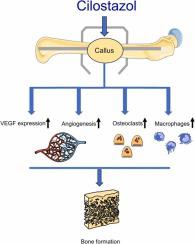当前位置:
X-MOL 学术
›
Biomed. Pharmacother.
›
论文详情
Our official English website, www.x-mol.net, welcomes your
feedback! (Note: you will need to create a separate account there.)
Cilostazol promotes blood vessel formation and bone regeneration in a murine non-union model
Biomedicine & Pharmacotherapy ( IF 6.9 ) Pub Date : 2023-10-19 , DOI: 10.1016/j.biopha.2023.115697 Maximilian M Menger 1 , Michelle Bleimehl 2 , David Bauer 2 , Claudia Scheuer 2 , Sandra Hans 2 , Dominik Saul 3 , Sabrina Ehnert 4 , Michael D Menger 2 , Tina Histing 3 , Matthias W Laschke 2
Biomedicine & Pharmacotherapy ( IF 6.9 ) Pub Date : 2023-10-19 , DOI: 10.1016/j.biopha.2023.115697 Maximilian M Menger 1 , Michelle Bleimehl 2 , David Bauer 2 , Claudia Scheuer 2 , Sandra Hans 2 , Dominik Saul 3 , Sabrina Ehnert 4 , Michael D Menger 2 , Tina Histing 3 , Matthias W Laschke 2
Affiliation

|
Non-unions represent a major complication in trauma and orthopedic surgery. Many factors contribute to bone regeneration, out of which an adequate vascularization has been recognized as crucial. The phosphodiesterase-3 (PDE-3) inhibitor cilostazol has been shown to exert pro-angiogenic and pro-osteogenic effects in a variety of preclinical studies. Hence, we herein investigated the effects of cilostazol on bone regeneration in an atrophic non-union model in mice. For this purpose, a 1.8 mm femoral segmental defect was stabilized by pin-clip fixation and the animals were treated daily with 30 mg/kg body weight cilostazol or saline (control) per os. At 2, 5 and 10 weeks after surgery the healing of femora was analyzed by X-ray, biomechanics, photoacoustic imaging, and micro-computed tomography (µCT). To investigate the cellular composition and the growth factor expression of the callus tissue additional histological, immunohistochemical and Western blot analyses were performed. Cilostazol-treated animals showed increased bone formation within the callus, resulting in an enhanced bending stiffness when compared to controls. This was associated with a more pronounced expression of vascular endothelial growth factor (VEGF), a higher number of CD31-positive microvessels and an increased oxygen saturation within the callus tissue. Furthermore, cilostazol induced higher numbers of tartrate-resistant acidic phosphate (TRAP)-positive osteoclasts and CD68-positive macrophages. Taken together, these findings demonstrate that cilostazol is a promising drug candidate for the adjuvant treatment of atrophic non-unions in clinical practice.
中文翻译:

西洛他唑促进小鼠骨不连模型中的血管形成和骨再生
骨不连是创伤和骨科手术的主要并发症。许多因素有助于骨再生,其中充分的血管化被认为是至关重要的。多种临床前研究表明,磷酸二酯酶 3 (PDE-3) 抑制剂西洛他唑具有促血管生成和促骨生成作用。因此,我们在此研究了西洛他唑对小鼠萎缩性骨不连模型中骨再生的影响。为此,通过针夹固定来稳定 1.8 mm 的股骨节段缺损,并且每天用 30 mg/kg 体重的西洛他唑或盐水(对照)经口治疗动物。术后 2、5 和 10 周,通过 X 射线、生物力学、光声成像和微型计算机断层扫描 (μCT) 分析股骨的愈合情况。为了研究愈伤组织的细胞组成和生长因子表达,进行了额外的组织学、免疫组织化学和蛋白质印迹分析。与对照组相比,西洛他唑治疗的动物表现出愈伤组织内骨形成增加,导致弯曲刚度增强。这与血管内皮生长因子 (VEGF) 更明显的表达、更多的 CD31 阳性微血管以及愈伤组织内氧饱和度的增加有关。此外,西洛他唑诱导了更多数量的抗酒石酸盐酸性磷酸盐(TRAP)阳性破骨细胞和CD68阳性巨噬细胞。总而言之,这些发现表明西洛他唑是临床实践中辅助治疗萎缩性骨不连的有前途的候选药物。
更新日期:2023-10-19
中文翻译:

西洛他唑促进小鼠骨不连模型中的血管形成和骨再生
骨不连是创伤和骨科手术的主要并发症。许多因素有助于骨再生,其中充分的血管化被认为是至关重要的。多种临床前研究表明,磷酸二酯酶 3 (PDE-3) 抑制剂西洛他唑具有促血管生成和促骨生成作用。因此,我们在此研究了西洛他唑对小鼠萎缩性骨不连模型中骨再生的影响。为此,通过针夹固定来稳定 1.8 mm 的股骨节段缺损,并且每天用 30 mg/kg 体重的西洛他唑或盐水(对照)经口治疗动物。术后 2、5 和 10 周,通过 X 射线、生物力学、光声成像和微型计算机断层扫描 (μCT) 分析股骨的愈合情况。为了研究愈伤组织的细胞组成和生长因子表达,进行了额外的组织学、免疫组织化学和蛋白质印迹分析。与对照组相比,西洛他唑治疗的动物表现出愈伤组织内骨形成增加,导致弯曲刚度增强。这与血管内皮生长因子 (VEGF) 更明显的表达、更多的 CD31 阳性微血管以及愈伤组织内氧饱和度的增加有关。此外,西洛他唑诱导了更多数量的抗酒石酸盐酸性磷酸盐(TRAP)阳性破骨细胞和CD68阳性巨噬细胞。总而言之,这些发现表明西洛他唑是临床实践中辅助治疗萎缩性骨不连的有前途的候选药物。















































 京公网安备 11010802027423号
京公网安备 11010802027423号